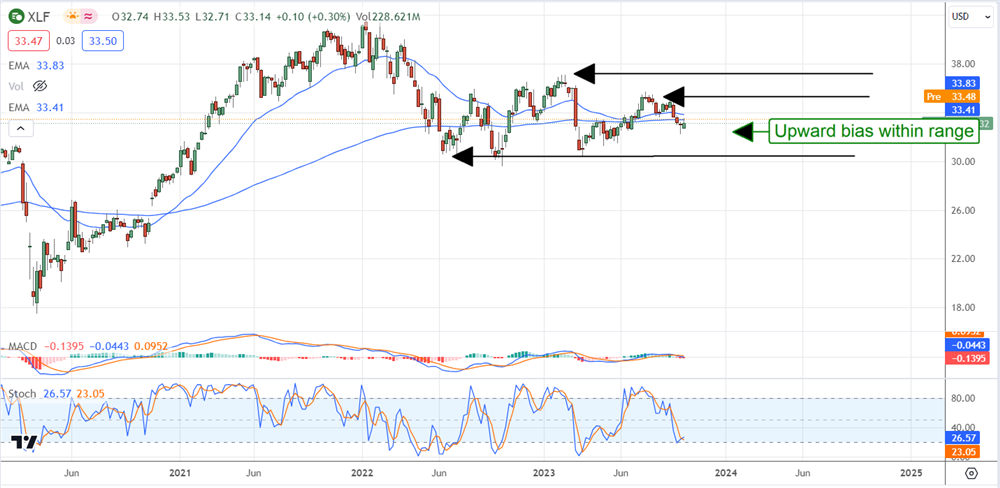5 Critical Details from Big Bank Results: JPM, C, and WFC The Big Banks have begun to report and the news is better than expected including improved tier 1 ratios, growing cash balances, and robust capital returns.
This story originally appeared on MarketBeat

Results from bank stocks JPMorgan Chase & Co. (NYSE: JPM), Wells Fargo (NYSE: WFC), and Citigroup (NYSE: C) are marking the start of peak Q3 earnings reporting season. The news is good, and the stocks are up, suggesting another better-than-expected season for the market. Investors will be pleased to know that despite the headwinds, consumers and businesses remain resilient, and the outlook for big bank earnings, dividends, and share repurchases is robust.
Economic Resilience and Higher Interest Rates Drive Results
The headline results are fantastic across the board. All 3 financial institutions reported a high-single to low-double-digit increase in top-line results compounded by wider margins. Results were mixed from bank to bank and segment to segment, but growth is generally present.
Higher interest rates and net investment income, aided by lower-than-normal credit costs, helped to drive margin. Margin is expected to normalize, but it could take some time, so revenue and earnings strength is expected to continue. Bottom-line results are far better than the top, with all delivering high-double-digit increases led by JPM (aided by the FRC acquisition).
Headwinds Persist, Rates Are Rising, and the Risks are Growing
Among the risks highlighted in the Q3 results are persistently tight labor markets, inflation, high and rising interest rates, the unknown impacts of soon-to-be-phased-in Basel III requirements, increasing amounts of QT, and the rapidly developing situation in the Middle East. In the words of JPM CEO Jamie Dimon, these are the most dangerous times for the economy and the market. The impact on oil prices alone is enough to keep inflation above target for the next several quarters, and there is a risk for oil prices to climb.
Assuming the Fed continues to hike rates, we can assume that more banks will fail, ultimately aiding growth for the largest, too-big-to-fail banks.
Charge-Offs Increase; Capital Reserves Increase; Tier 1 Ratios Strong
Among the risks are a rising number of chargeoffs. The chargeoffs vary from financial institution to institution but run in the high-double-to-low-triple-digit percentage range. The good news is that charge-offs are still within normalized levels, and capital reserves are also rising.
The net increase for these 3 banks runs near $3.35 billion, and all reported an improvement in their tier 1 capital ratios. JPM is the best positioned with a ratio of 14.3%, but all are above the minimum requirements, including new requirements that will come into effect over the next few quarters.
The Cash is Flowing in the Financial Sector
The cash flows in the financial sector, and the banks are returning profits to their shareholders. The banks returned nearly $9.5 billion in dividends and share repurchases, with about $4 billion in repurchases and dividends of nearly $5.35. JPM returned the most capital, including repurchases, and all pay a nice yield; JPM is the lowest at 2.85%, but Citigroup stands out. This company is paying more than 5%, with shares trading near recent lows.
The Big Banks Provide Stable, Steady Value for Investors
The Big Banks are heavily regulated and face headwinds like any other business but appear to be in solid financial health. In this light, the ultra-low 7.3X to 9X earnings at which they trade suggests a deep value for investors. These stocks are paying more than double and triple the broad market while trading at less than half the value, with an outlook for steady, stable income in 2024. The biggest risk is a recession, and even in that event, the tier 1 ratios, capital reserves, and balance sheets suggest they are well-prepared.
The Technical Outlook: Banks Rise on Earnings, XLF Still Range Bound
The Big Banks are moving higher following results, and the XLF Financial SPDR (NYSEARCA: XF) is moving up with them. The caveat is that the movement in the XLF is tepid and suggests the market will remain in range despite the upward bias. This means potential for mid-single-digit gains in the near term with a chance the market could break to a new high. The 1st hurdle is at $35.50; a move above that could continue to the $37 level.











